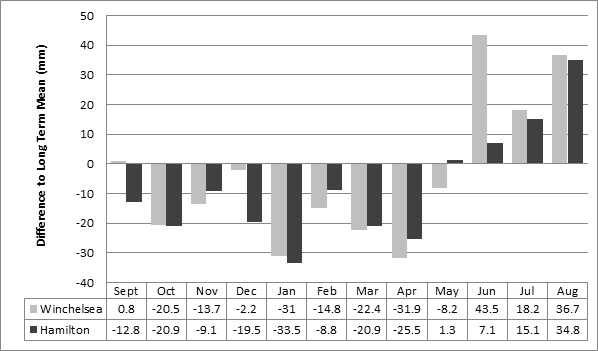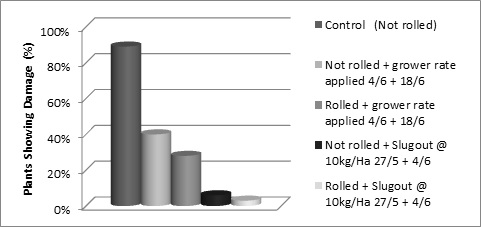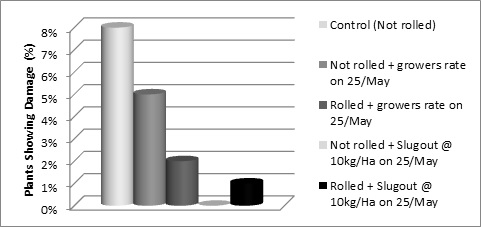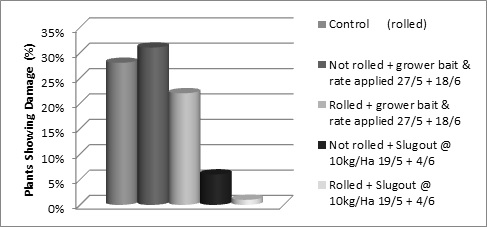Slug management practices; what is working?
Author: Jon Midwood | Date: 20 Aug 2014
Jon Midwood,
Southern Farming Systems
Take home messages
- Managing slug populations is unlikely to be successful unless both cultural and chemical control strategies are used.
- Research has found burning, light cultivation and rolling improves slug control.
- Control measures must be carried out before slug damage is observed.
- Paddocks with a previous history of slug damage are always a good place to start monitoring in a susceptible crop like canola.
- Slug bait should be applied at a rate to provide sufficient bait points per m2 relative to slug populations in the paddock.
- Check the accuracy of your bait spreader to make sure there is an even distribution of bait across the spreading width. This width may not be the same as the width you spread urea.
- Identify slug species present in a paddock for the most effective control. Different species demonstrate different behaviours.
Introduction
Slugs are a major pest that regularly damage emerging and seedling canola, fodder rape, pasture legumes and to a lesser extent cereal crops and pulses. The consequences and costs of slugs and damage or the potential to cause damage are:
- Re-sowing (additional seed and sowing costs and not sowing at the optimum time and hence potential yield is reduced).
- Costs of baits and baiting (multiple applications).
- Burning of stubble.
- Cultivation.
- Reduced area sown to canola.
Slugs have been an intermittent pest of crops in the HRZ. However, the frequency and level of damage caused by this pest has gradually increased over time. Slugs are now constant and major pests that frequently cause significant damage to crops at emergence and during the establishment phase. This may be attributed to a number of factors including the increase in adoption of stubble retention and reduced tillage and increased area of susceptible crops such as canola. The area of damage caused by slugs has increased irrespective of favourable climatic conditions, including the drought of 2006.
Slugs have caused significant damage to some canola during the germinating and early establishment phase of crops in 2013, especially in areas where damage had been seen previously. The extent of damage was unexpected given the very dry conditions of summer and autumn. The adoption of stubble retention has favoured this pest through increased soil moisture holding capacity and the stubble providing a refuge for the slugs to survive.
Knowledge and skills to monitor slug populations and implement an effective slug control strategy are critical to reduce the impact of slugs. Currently growers, agronomists and advisers do not always use effective strategies that will consistently control slugs below thresholds for growing canola. The most common strategy often starts with applying slug bait once damage is seen in the establishing crop. Unfortunately this approach is reactionary and doesn’t lead to the most effective level of control. Following the very high levels of damage seen in 2011, many growers are now looking to include additional cultural control techniques; including burning of stubble, cultivation and rolling.
During the spring of 2012 the GRDC HRZ Regional Cropping Solutions group put forward the research topic of “managing slugs in the HRZ” as a major priority for growers and advisers. As a result, a fast track project was initiated to demonstrate and evaluate a range of management strategies that could effectively reduce damage to emerging canola during establishment caused by slug species in the High Rainfall Zone (HRZ).
Twelve farms were surveyed across the western districts of southern Victoria that were considered suitable as potential trial sites based on grower and adviser recommendations. All had sufficient slugs in the spring sampling to be potential trial sites. The key factor for the project would be, what would happen to the slugs over the summer, and what mortality rates will occur? The aim was to have at least three final sites which fitted the project criteria, with the target species being the Grey Field Slug (Deroceras reticulatum), as this is the dominant species in the western districts and at least one site where Black Keel slug (Milax gagates) was the focus species. The rationale for this was that there is a shift in species prevalence in response to seasonal conditions, and therefore, it is important to understand management control options for both kinds of slug species. The final sites were at Inverleigh (east), Skipton (central) and Hamilton (west).
The very dry conditions experienced in southern Victoria over the summer months affected the final methodology used in the project and some cultural management techniques were not employed either by grower request or by what was actually achievable at each site. The data below shows the variation from the long term mean at two of the sites, from September 2012 to August 2013. Winchelsea BOM rainfall was used for the Inverleigh site.

Figure 1. Difference in actual rainfall at 2 sites compared to the Long term mean from September 2012 to August 2013.
The final trial plan was:
- Stubble – all stubble from the previous crop was burnt.
- Cultivation – none undertaken as too dry and growers didn’t want to use this intervention.
- Rolling – rolling versus control. This was carried out using rubber tyre rollers.
- Grazing – grazing versus ungrazed. Only one site grazed the stubble pre burning.
- Baiting:
- Applied immediately after sowing versus “grower strategy” baiting versus double bait.
- Applied at full label rate versus “grower rate”.
Results
Inverleigh Site
The canola variety, Crusher, was sown on the 21st May into burnt barley stubble. Sowing rate of 4.2kg/ha on a 300mm row spacing. The slug species identified in this trial were the grey field slug (Deroceras reticulatum), the black keeled slug (Milax gagates) (Black Keeled Slug) and the striped field slug (Lehmannia nyctelia).

Figure 2. Effect of each treatment on the plants displaying any slug damage (Inverleigh trial).
Skipton Site
The canola variety, Thunder, was sown on the 17th May into burnt wheat stubble which was grazed. Sowing rate of 4.0kg/ha on a 220mm row spacing. The slug species identified in this trial was the grey field slug (Deroceras reticulatum).

Figure 3. Effect of each treatment on the plants displaying any slug damage (Skipton trial).
Hamilton Site
The canola variety, Thunder, was sown on the 14th May into burnt wheat stubble. Sowing rate of 3.5/ha broadcast and prickle chained. The slug species identified in this trial were the grey field slug (Deroceras reticulatum) and the black keeled slug (Milax gagates).

Figure 4. Effect of each treatment on the plants displaying any slug damage (Hamilton trial).
What did we learn?
Timing of the bait
All the managed bait applications showed the lowest level of slug damage across all sites. This application was also applied post sowing but pre emergence of the crop and this gave a substantially improved level of control especially at Inverleigh and Hamilton where the first grower application was applied 8 days later.
Influence of Rolling PSPE
All sites showed a positive result from rolling immediately after sowing compared to not rolling. This was especially noticeable at Inverleigh and at Hamilton where there were higher slug numbers and damage. This was nicely demonstrated at Hamilton where the control treatment was rolled and resulted in less crop damage compared to applying bait but not rolling. This is a cheap, non-chemical, cultural control technique which restricts slug movement in the seed bed and also helps to consolidate soil around the newly sown seed, and therefore, improves establishment.
Rate of Slug Bait
It is difficult to draw any conclusions from the differences in rates of product used as there were also differences in timing of application, which in itself almost certainly had a major influence on control. However, growers are often driven by what a bait will cost them per hectare and its perceived ability to tolerate wet weather and remain active (i.e. not disintegrate). In light of this we looked at five commonly used baits and measured bait points/m2 at full label rate compared to commonly used “grower rates” (Figure 5).
For many slug bait products, growers tend to have their own rates of application. This is often driven by cost/ha and can also be influenced by what rate their bait spreader is set up at! A common application rate is 4 to 5 kg/ha which equates to $30 - $35/ha. However, this is very often applied without any understanding of bait points per square metre, which needs to be at about 25/m2 for a paddock population of 20 slugs/m2,assuming 80% encounter (Nash 2013). A slug population of one per square metre is significant, and is considered the damage threshold for canola. An infestation of eight slugs per square metre is considered severe (Sabeeney 2013).

Figure 5. Bait points per square meter at various application rates (kg/ha).
Spreading Slug Bait
Recent research carried out by Ashley Wakefield and Greg Baker in SA on the distribution of slug and snail bait from standard farm spreaders adds further potential inaccuracy to applying bait:
- Many growers assume bait spreading requires the same machinery setup as urea spreading.
- Many growers are not spreading the product as widely as they think when using spreaders set-up for urea rather than for bait.
- Ute spreaders, set up for urea to spread to 15 meters were spreading bait to 7 meters only.
- Fertiliser spreaders, thought to be spreading bait to 35 meters were spreading bait to 20 meters only.
- During the spreading process, some of the bait was breaking up into smaller pieces. At this stage this is not seen as either a disadvantage or an advantage.
Species Identification
At both the Hamilton and Inverleigh trials, damage levels were higher than at the Skipton trial. One explanation for this may well have been the presence of two species of slugs which can live at different depths in the soil.
The Grey field slug or reticulated slug (Deroceras reticulatum) is mainly surface active and can have up to three generations a year. It will generally breed in autumn and spring however, if conditions are favourable this species will breed any time, and therefore, a pair can produce up to 1000 eggs a year. The second species identified at these two sites was the Black keeled slug (Milax gagates). This species can burrow up to 20 centimetres underground to escape the heat. A breeding pair can lay up to 200 eggs a year.
The importance of identification of the species relates to the emergence of each species as the autumn break developed. At the very early emergence stage of canola, only grey field slugs were causing plant damage but as the wet front penetrated the soil profile with increased rain, the black keeled slugs became active. This meant that only applying the initial bait treatment PSPE wasn’t going to be sufficient to control the later emerging species.
Contact details
Jon Midwood23 High Street, Inverleigh, VIC 3321
03 5265 1666
jmidwood@sfs.org.au
GRDC Project Code: SFS0023,
Was this page helpful?
YOUR FEEDBACK
